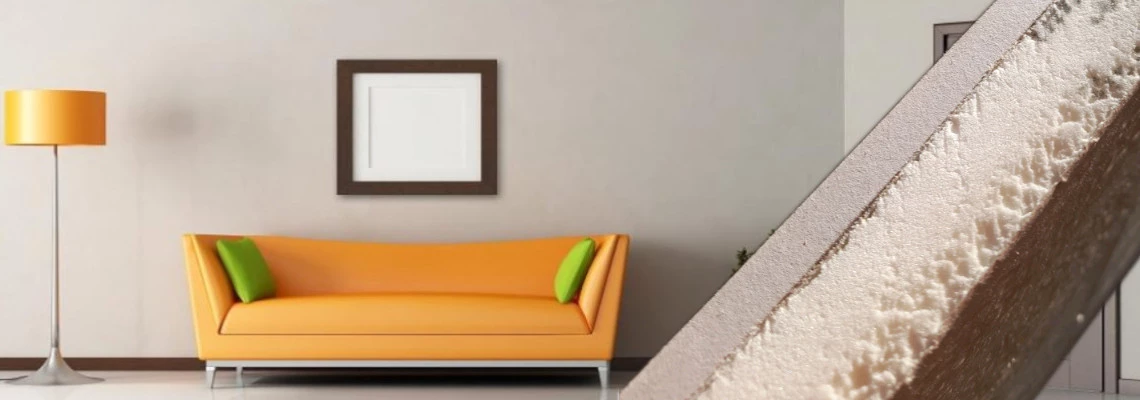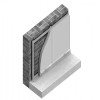
Be smart. Use Insulated Plasterboard and
Maximize The Room Space*
About 16% to 25% of heat in the home escapes through walls. Adding thermal insulation between the solid wall and internal plaster of a room is common practice in UK.
In general, the more expensive the insulation, the thinner its structure. Thickness of internal wall insulation varies. It is worth to anticipate it to be anywhere from 50mm to 120mm.
There are still lot of houseowners using standard "old school" techniques when insulating internal walls. Other people are using better, less time consuming methods.
When installing standard plasterboard, you have to put insulation in place between the plasterboard and the internal wall of the room you’re decorating.
This requires installing stud work first, then fill the gap with insulation. That is not the end. Yet, you must fix plasterboards. While standard method is fine for most of the DIY's, insulated plasterboard is a live-changing product. It simply offers more benefits.
Here is the 5 reasons why you should choose insulated plasterboard. You might also want to see the costs.
Reason 1. Thickness
Using 4’ x 2’ timber, the wall thickness would end up being just over 5’ inches thick, after screwing half inch plasterboard and skimming. To fill 5 inches wall you will need 100mm Acoustic roll. In fact, that is allready twice as much compering to 50mm PIR rigid insulation boards.
Using insulated plasterboard you are not limited to any thicknesses. Board sizes start from 24.5mm, however Building Regulations must be taken into consideration. However, using 62.5mm insulated plasterboard will do the same job as 100mm of Acoustic roll. With 62.5mm board you should expect to see a reduction in your heating bills by around 25%.
Moreover, according to Thegreenage.com “ the first centimetre of internal wall insulation will do more than the next and so on. The first 100mm of insulation is where the energy savings are really significant.”

Diminishing impact of extra insulation
Picture credit:https://www.thegreenage.co.uk/what-is-the-recommended-thickness-of-loft-insulation/
Reason 2. "2 in 1" Product Cost 
Insulated plasterboard is best 2-in-1 product ever invented. Why? The reason for this is pretty simple. Board insulates and dry lines walls in one simple application. Moreover, it is designed to give your house thermal benefits.
In fact, it is a cheaper solution than buying both constituent parts. Therefore it has been incredibly popular due to installation time and cost. The reason behind this is mostly speed of installation. You won't have to do same thing twice. You simply pay for labour once.
System Comparison
The UK average day rate for a carpenter or joiner is £180.
Each room will take around 7 days to build a stud wall and fit insulation. That give us figure of £1260 for the labour cost itself. Compering to insulated plasterboard that is almost 4 times more.
When insulating walls with insulated plasterboard carpenter will be able to dot and dab boards within 2 days. That is total of £360. You save £900. Not bad, isn't it?
Standard Stud Wall Insulation Material Costs
When buying both constituent parts, timber battens and insulation, you pay either per m2 or lm. For instance 6m x 2.6m wall will require 19no 8'x4' timber battens to build a stud wall.
[Date: 28.04.2022]
According to "BuildingDepot.com" current price list, that give us a cost of £255.36 for timber itself. Box of 200 Screws needed for a job will add another £68.96 to our basket. Now we need insulation. To fill and cover 15.6m2 you will need 2 Acoustic insulation rolls. Again, that is extra £159.38. To cover 2.6m x 6m wall with plasterboard you will need 6 wallboards £47.16.
Standard method ( stud wall + 100mm acoustic roll + screws + wallboard ).
£ 255.36 + £68.96 + £159.38 + £47.16 = £530.86
Insulated Plasterboard Costs
Accordingly you will need 6 boards to cover 15.6m2. That give us a figure of £312.36 ( £52.06 per board ) plus 3 bags of plasterboard adhesive £29.73.
Insulated plasterboard ( 50mm PIR bonded to plasterboard + wallboard adhesive ).
£312.36 + £29.73 = £342.09
Let's bring those figures close together
£530.86 - £342.09 = £188.77
£188.77 ( product savings ) + £900 ( labour savings) = £1049.77
£1049.77 figure is based on 15.6m2.
The costs given here are given in good faith as an indicative guide only and should be used with understanding.
Insulationgo Limited cannot accept any liability for any budget produced using these figures.
Please note, you should always seek professional advice in producing a budget for any internal wall insulation project.
Reason 3. Labour Cost 
Labour costs are the main factor when choosing the product. Paying £1260 or £360 makes a huge difference for any budget. That is why the insulated plasterboard stands on the podium here, with the number 1, of course.
Reason 4. Continuous Insulation and Wall Strength 
When insulating internal wall there is one simple rule to follow- if you want to insulate your wall well, use continuous insulation method.
Continuous insulation can serve several important functions in a high-performing wall system including continuous thermal insulation, moisture vapor control, water resistive barrier and air barrier.
Continuous insulation is installed continuously over the studs not inside the studs.
Using this method, we provide the best possible insulation for a wall. Why? The answer is simple. Instead of 30 connections inside the structure, we minimize it to 3-4 connections.
You should always try to achieve a seamless ‘blanket’ of insulation across the entire wall.
Reason 5. Spacesaver Insulation 
.
For many thermal insulation applications, space is a premium. The benefits of thin insulated plasterboard are that it can have a significant impact not only on performance but also reducing heat loss from buildings.
If a thermal insulation material is too thick, this can restrict its application. Thicker insulation can also increase costs in other follow-up building alterations, such as fitting wider window sills.
In UK houses, thin thermal insulation is essential. This is where insulated plasterboard takes its place.
Insulated plasterboard is highly effective as a thin form of thermal insulation. Why? This space-saving board consists a PIR foam core that can adhere using gypsum adhesive. Of course, thicknesses may vary according to application, but some of sheets are as thin as 27.5mm thick.
Other Articles:
Bibliography
1. builderdepot.co.uk/, accessed April 28, 2022
https://www.builderdepot.co.uk/timber-sheets/carcassing-timber/ts_size--4-x-2-1
2. thegreenage.co.uk, “What is reccomended thickness of loft insulation” May 25, 2017, accessed April 28, 2022
https://www.thegreenage.co.uk/what-is-the-recommended-thickness-of-loft-insulation/
*All the information provided in the content published on Insulationgo blog is for informational and educational purposes only. Insulationgo LTD makes every effort to ensure the accuracy and timeliness of the content, but we do not assume any responsibility for any errors or omissions.
The information presented on this blog should not be considered as professional advice or a substitute for consulting relevant experts. Before making any purchase decisions or taking action based on the information presented here, it is strongly recommended to contact the product manufacturer directly to verify the details and ensure its suitability for your specific needs.
By using this blog, you acknowledge and agree that Insulationgo LTD shall not be held liable for any damages, losses, or inconveniences arising from the use or reliance on the information provided herein. This limitation of liability applies to all users of the blog, including but not limited to visitors, readers, and subscribers.










































































































